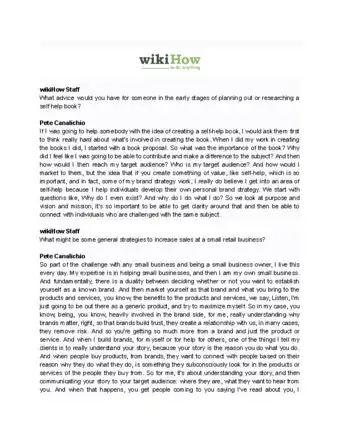This article was co-authored by Pete Canalichio. Pete Canalichio is a Brand Strategist, Licensing Expert, and Founder of BrandAlive. With nearly 30 years of experience at companies such as Coca-Cola and Newell Brands, he specializes in helping brands find the most authentic parts of their story to build a brand strategy. Pete holds an MBA from the University of North Carolina at Chapel Hill and a BS in Physics from the United States Naval Academy. In 2006, he won an MVP Award from Newell Brands for his contributions to their Global Licensing department. He’s also penned the award-winning book, Expand, Grow, Thrive.
There are 7 references cited in this article, which can be found at the bottom of the page.
This article has been viewed 73,049 times.
The first TED conference in 1984 brought together people from the fields of technology, entertainment, and design. In the decades since, it has expanded to include a second annual conference, TEDGlobal, as well as the TED Fellows and local TEDx programs, and an annual TED Prize. TED also features a series of videos recorded at its conferences and by its partners, the TED Talks, given by speakers in many fields who share the organization's mission of spreading ideas.[1] If you have an idea worth spreading, you may wish to give a TED Talk or simply emulate its format.
Steps
Deciding What to Give a TED Talk On
-
1Choose a subject you're passionate about. TED Talks are about “ideas worth spreading.” Part of this means you should be emotionally invested in what you plan to speak about. Planning a talk on something you're enthusiastic about will motivate you in the planning and refining of your TED Talk and will carry through to your audience when you deliver it.
-
2Choose a subject you have expertise in. You don't have to be the world's foremost expert in your topic, but you do have to know enough to give accurate information in those areas where you have expertise and to seek out experts and peer-reviewed sources for any material where you're not an expert yourself.[2]Advertisement
-
3Evaluate your topic for your audience. Your TED Talk should be focused on the needs and interests of your audience. Look for places where your audience's passion matches your own and build on those, as well as taking the following into account:
- Your idea should be something your audience hasn't heard before, or at least not in the way they've heard it presented before.
- Your idea should be a realistic one, something that your target audience can put into practice or be able to get the right people in their personal networks to put into practice. [3]
-
4Define and refine your premise. Once your idea is something you can relate to your audience and have them relate to you, you have a premise for your talk. Your premise should be one you can state in one or two sentences. [4] You may have to revisit your idea several times to define your premise clearly.
-
5Know your time limit. TED Talks currently are no more than 18 minutes in length. You do not have to use the full 18 minutes for your talk; some ideas can be stated succinctly and completely in 5 minutes or less. You can't go over 18 minutes, however. [5]
- If you're given a shorter time limit when asked to speak at a TED event, use that time limit instead.
-
6Review several TED Talk videos to develop an understanding of the format. You're not looking to copy the style of a particular speaker, but to get an overview of possible styles to find what feels right to you. Look at several TED Talk videos in areas similar to what you plan to talk about, as well as videos in areas that interest you that may be outside what you plan to talk about.<
-
7Determine the primary purpose of your TED talk. While the TED Talks in general are about sharing ideas, your TED talk will share your idea primarily in one of three ways:
- Education. These TED talks inform the audience about the world around them. Topics often include the biological, physical, or social sciences, as well as information on new technologies and inventions and how they will impact the listeners' lives. The speakers for these talks often have advanced degrees in one of the sciences, but not always.
- Entertainment. These TED talks often cover the creative arts, whether it be writing, art, music, or performing, and delve into the process behind the art.
- Inspiration. These TED talks seek to elevate their audience's perception of themselves and the world around them, to think about things in new ways, and to apply that knowledge to their lives. Many of the speakers of this type of TED talk use their own experiences as examples to others.[6]
Preparing Your TED Talk
-
1Develop an outline. Once you have established the premise and purpose of your TED talk, you should craft an outline to present your idea in a way that your audience will care about and understand the facts behind them and how it will affect them if they choose to embrace it.
- Your outline, however, should be something your audience can discern without being obvious. In other words, you don't tell them what you're going to say before you say it (no “Here's what I'm going to share with you today”) and what you've said after you say it (no “And in conclusion …”).[7]
- If you've been scheduled to speak at a TED event, your outline, or a full script, needs to be sent to the event organizer about two months in advance of your appearance. This lets the event organizers provide preliminary feedback.[8]
-
2Provide a strong introduction. Your introduction should grab your audience by presenting your idea as quickly as possible without drawing excessive attention to yourself as the speaker.
- If your idea is one your audience knows is relevant to them, state it clearly early on. If it's not one your audience realizes is relevant to them, show them how it relates to something they do know is relevant to them,
- If your idea is an emotionally heavy one, start with an understated but forthright approach. Let your audience come to feel about the topic instead of dictating their emotions.
- Avoid using a string of statistics. A single relevant fact carries more weight, particularly if it comes as a surprise to your audience. [9]
-
3Identify what evidence supports your premise. List out what the audience already knows and what they need to know, then organize this information into a series of points, where each point presents information that will help your audience grasp the next point. As you do this, weed out information that your audience doesn't need to know, even if you may think it's important.
- Keep and devote more time in your talk to information that's new to your audience and eliminate and devote less time to things they've already heard.
- Use more evidence that's supported by your own and your audience's observations and experience (empirical evidence) than by telling what happened to someone else (anecdotes).
- Keep the use of specialized terminology to a minimum and, where possible, present it in such a way that your audience can figure out the definition in context.
- Respectfully acknowledge legitimate doubts and contrary evidence.
- Save citations until after you've made your point or post them in small print at the bottom of relevant slides.
- Consider having someone help you gather and select your evidence. [10]
-
4Look for places to visually support the body of your talk with slides. Slides aren't required for TED talks, although you can use simple slides to support your key points without distracting your audience. You can put the slides together yourself in a presentation program such as PowerPoint or Keynote, or enlist a designer's help. Keep the following things in mind when preparing slides:
- Contact the event organizer for information about the resolution and aspect ratio for slides before you start making any. If the organizer doesn't provide you any technical specs, use a resolution of 1920 x 1080 pixels and an aspect ratio of 16 to 9.
- Use each slide to support only one point in your talk. Avoid using bullet points to make multiple points in your presentation.
- Let the slide speak for itself. Don't put a lot of explanatory text on the slide or devote time to explain what the picture on the slide represents. If your slide features a chart or infographic, keep it simple.
- Use only images you own or have permission to use. If you're using an image under a Creative Commons license, cite the source of the image at the bottom of the slide.
- Either fill the entire slide with your image or keep it in the center of the slide; don't put content in the edges.
- Use a sans serif font (Arial, Helvetica, Verdana) of point size 42 or larger. (Sans serif fonts are easier to read from a distance than serif fonts like Times New Roman.) If you are using a custom font, be sure to send it to the organizers in advance. [11] (Presentation software typically can display only the fonts installed on the projecting computer.)
-
5Conclude on a high point. Instead of providing a summary, your conclusion should be something that leaves your audience with a positive feeling about your idea and how it will affect them if they choose to implement it.
- Your conclusion may include a call to action, if appropriate, as long as that call to action isn't a sales pitch asking them to buy something. [12]
Rehearsing Your TED Talk
-
1Practice with a timer. Because you do have a time limit for your TED talk, practicing with a timer will help you pace your talk so you stay within your allotted time and identify places to cut for length.
-
2Practice with various test audiences. The TED organization encourages speakers at its conferences to practice their talks as many times as they can in front of as many different audiences as possible. You can practice in front of any or all of the following audiences:
- Yourself in a mirror. This lets you practice your body language.
- Family and friends. These can provide initial feedback, but may be more useful as a source of encouragement.
- A personal speaker coach.
- A speakers' group, such as Toastmasters.
- A class related to the subject of your talk. For example, if your TED talk relates to marketing, you could speak in front of a college marketing class.
- A company speaker event, either at your own company or a company connected in some way to your talk.[13]
-
3Rehearse under the TED auspices, as well. Most TED events also provide opportunities for you to practice your talk, using either or both of these formats:
- Online rehearsals through Skype. These let the event organizers provide feedback on how your talk is structured, how well you've paced it, and how clearly you deliver it. These online rehearsals usually are scheduled a month in advance of the event.
- Dress rehearsals on stage at the event site. These provide you with an opportunity to familiarize yourself with the venue, as well as to prepare for any possible surprises, such as unexpected laughter.[14]
Giving Your TED Talk
-
1Get to know the people you'll be speaking to before you give your talk. Talk to the other TED event attendees on a casual basis during time away from the event stage. This will let you get to know how well your actual audience matches with your imagined audience and also provide some familiar faces in the crowd when you go on stage.
-
2Stick to your planned delivery style. Although you may have revised the content and presentation of your talk a number of times based on the feedback you've gotten from rehearsing it, once you have a style you're comfortable with, stick with it. Don't make any last-minute changes to your delivery.
-
3Remember why you're giving a TED talk. While you've spent time creating and refining your message, it's not for the sake of the information but about sharing it and your enthusiasm for it with your audience.[15]
Expert Q&A
-
QuestionHow do you deliver a powerful presentation?
 Pete CanalichioPete Canalichio is a Brand Strategist, Licensing Expert, and Founder of BrandAlive. With nearly 30 years of experience at companies such as Coca-Cola and Newell Brands, he specializes in helping brands find the most authentic parts of their story to build a brand strategy. Pete holds an MBA from the University of North Carolina at Chapel Hill and a BS in Physics from the United States Naval Academy. In 2006, he won an MVP Award from Newell Brands for his contributions to their Global Licensing department. He’s also penned the award-winning book, Expand, Grow, Thrive.
Pete CanalichioPete Canalichio is a Brand Strategist, Licensing Expert, and Founder of BrandAlive. With nearly 30 years of experience at companies such as Coca-Cola and Newell Brands, he specializes in helping brands find the most authentic parts of their story to build a brand strategy. Pete holds an MBA from the University of North Carolina at Chapel Hill and a BS in Physics from the United States Naval Academy. In 2006, he won an MVP Award from Newell Brands for his contributions to their Global Licensing department. He’s also penned the award-winning book, Expand, Grow, Thrive.
Brand Strategist & Licensing Expert Go beyond the words in your speech and try to convey the emotions behind them. Let's say you're talking about your first experience flying a plane solo—you might remember back to how scared you were before pushing up the power and letting the plane take off. Showing that emotion of fear, exhilaration, or happiness are things that make a delivery really, really powerful.
Go beyond the words in your speech and try to convey the emotions behind them. Let's say you're talking about your first experience flying a plane solo—you might remember back to how scared you were before pushing up the power and letting the plane take off. Showing that emotion of fear, exhilaration, or happiness are things that make a delivery really, really powerful. -
QuestionCan a teenager deliver a TED talk?
 PenguinpencilCommunity AnswerYes, you can if you have something to say! Some teenagers have talked about the very nature of being a teenager.
PenguinpencilCommunity AnswerYes, you can if you have something to say! Some teenagers have talked about the very nature of being a teenager. -
QuestionI clicked on "surprise me" and this came up. This may be wierd to ask but, what's a TED talk?
 Community AnswerTED talks are conferences organized by a media company where experts in their field get up before an audience and talk about whatever they are experts in. The talks are usually thought-provoking, informative, and cover a wide range of topics, including education, business, science, creativity, etc.
Community AnswerTED talks are conferences organized by a media company where experts in their field get up before an audience and talk about whatever they are experts in. The talks are usually thought-provoking, informative, and cover a wide range of topics, including education, business, science, creativity, etc.
Warnings
- Adding humor to a TED talk can be helpful, but not in excess. Most stand-up comedy routines involve connecting a series of unrelated subjects instead of a series of related points.[17]⧼thumbs_response⧽
Expert Interview

Thanks for reading our article! If you'd like to learn more about speaking in conferences, check out our in-depth interview with Pete Canalichio.
References
- ↑ http://www.ted.com/pages/about
- ↑ http://storage.ted.com/tedx/manuals/tedx_speaker_guide.pdf
- ↑ http://storage.ted.com/tedx/manuals/tedx_speaker_guide.pdf
- ↑ http://storage.ted.com/tedx/manuals/tedx_speaker_guide.pdf
- ↑ http://storage.ted.com/tedx/manuals/tedx_speaker_guide.pdf
- ↑ http://www.theglobeandmail.com/report-on-business/small-business/sb-managing/leadership/7-tips-for-choosing-your-ted-talk-idea/article15182124/
- ↑ http://www.forbes.com/sites/nickmorgan/2012/04/02/giving-a-presentation-dont-tell-em-what-youre-going-to-say/
- ↑ http://www.inc.com/magazine/201310/burt-helm/how-to-give-a-great-ted-talk.html
- ↑ http://storage.ted.com/tedx/manuals/tedx_speaker_guide.pdf
- ↑ http://storage.ted.com/tedx/manuals/tedx_speaker_guide.pdf
- ↑ http://storage.ted.com/tedx/manuals/tedx_speaker_guide.pdf
- ↑ http://storage.ted.com/tedx/manuals/tedx_speaker_guide.pdf
- ↑ http://www.webinknow.com/2013/05/how-to-prepare-and-deliver-a-tedx-talk.html
- ↑ http://www.inc.com/magazine/201310/burt-helm/how-to-give-a-great-ted-talk.html
- ↑ http://www.inc.com/magazine/201310/burt-helm/how-to-give-a-great-ted-talk.html
- ↑ http://www.theglobeandmail.com/report-on-business/small-business/sb-managing/leadership/7-tips-for-choosing-your-ted-talk-idea/article15182124/
- ↑ http://www.theglobeandmail.com/report-on-business/small-business/sb-managing/leadership/7-tips-for-choosing-your-ted-talk-idea/article15182124/














































































